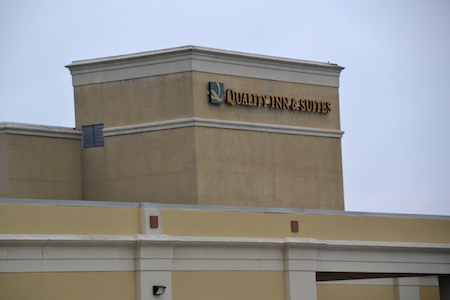Orleans ranks last in visitor spending among all counties in NY

Photo by Tom Rivers: The St. Mary’s Archer’s Club on the Oak Orchard River in Carlton attracts many out-of-state fishermen each fall. This group is pictured on Oct. 29, 2015. Fishing is the county’s leading tourism draw, accounting for about half of the $24 million total.
ALBION – Tourism is big business in New York State, generating $63.1 billion in visitor spending in 2015.
Many counties, including some small ones, bring in well over $100 million in tourism revenue. But no county brings in less than Orleans, which totaled $24.421 million in visitor spending in 2015. That is dead-last among the 62 counties in New York State, and about $4 million less than the 61st-ranked county, Chenango, at $28.455 million, according to a report by Tourism Economics and Empire State Development.
Orleans County certainly has assets with Lake Ontario, the Erie Canal, numerous historical sites and community festivals and events.
The county is hurt by not having an established chain hotel. That limits many visitors to day trips where they don’t stay overnight, minimizing some of their economic impact.
The Orleans Economic Development Agency has been reaching out to hotel providers, and is hopeful a new chain, Cobblestone Inn and Suites, will commit to a site in Medina. The EDA commissioned a study by Interim Hospitality Consultants, and that report concluded Medina could support a small hotel with 41 to 49 rooms.
Jim Whipple, the chief executive officer of the Orleans EDA, said investors haven’t committed to the Medina project yet. The EDA razed a house next to the new Pride Pak on Maple Ridge Road and installed infrastructure to make the site more attractive for developers.

Batavia is home to several chain hotels, including the Quality Inn & Suites. Genesee County has about 1,000 hotel rooms.
If a chain hotel comes to Orleans it would help capture more visitor spending, and also boost the “bed tax” leading to more money for marketing the county.
The bed tax raises about $35,000 annually to promote tourism in Orleans County. That 4 percent tax is charged by motels, bed and breakfasts, vacation rentals and lodges.
In neighboring Genesee County, there are nearly 1,000 hotel rooms along the Thruway corridor. They generate more than $400,000 a year to promote tourism, drawing more visitor spending to Genesee, where direct tourism spending totaled $93.360 million in 2015.
The counties are similar in size: Orleans County had 42,883 residents in 2010 while Genesee counted 60,079. Chenango, which is just above Orleans in tourism impact, had 50,478 people in 2010. Chenango, in its tourism promotions, boasts of an “idyllic rural quality lifestyle.”
Orleans County, in its promotions, urges visitors to: “Discover the charm as you cruise along our country byways and scenic waterways while experiencing our rich history, rural culture and exhilarating outdoor fun. Don’t forget to stop in at our bountiful farm markets, charming gift shops and unique museums along the Erie Canal, Historic Ridge Road and the Seaway Trail.” (Click here to see the county’s tourism website.)
Orleans has made one recent change to boost its focus on tourism. For many years, tourism was part of the Planning Department. The county now contracts with Lynne Menz for tourism services. She runs the tourism website, and also handles print promotions for the county. (Many other counties, such as Genesee, contract with the Chamber of Commerce to promote tourism, and the tourism officials work out of the Chamber. In Orleans, Menz works out of the County Administration Building.)
The county also secured a grant for a study of assets and opportunities along the 25 miles of Lake Ontario shoreline in the towns of Yates, Carlton and Kendall. Representatives from those three towns and the county are working to update a plan to better capitalize on the lake.
“I think Lake Ontario could be a bigger driver,” said David Callard, chairman of the Orleans County Legislature. “We’re looking to enhance it.”
The state is also planning to pave some sections of the Lake Ontario State Parkway, from Route 237 in Kendall headed east. The deteriorated condition of the Parkway has discouraged many motorists, especially those with RVs, from using the road.
Fishing is the county’s leading tourism draw, accounting for about $12 million in direct visitor spending or about half of the county’s total tourism spending. Callard thinks fishing could bring in more money, especially with amenities in place for wives and children of many of the anglers.

Fourth-graders from School No. 2 in Rochester visit the Urger, a historic tugboat, on Oct. 7, 2015 when the vessel was in Holley.
Callard would also like to see the canal communities work together to develop a comprehensive plan for enticing more visitors to Medina, Albion, Holley and the canal hamlets.
“We have to do smelting bigger and better to attract people,” he said.
Here are how the counties rank in direct visitor spending, from lowest to highest:
• Orleans, $24.421 million; Chenango, $28.455 million; Tioga, $29.149 million; Washington, $29,935 million; Schuyler, $37.546 million; Montgomery, $39.202;
• Lewis, $39.958 million; Wayne, $40.785 million; Wyoming, $41.303 million; Livingston, $48.608 million; Seneca, $49.120 million; Schoharie, $53.807 million;
• Fulton, $54.170 million; Putnam, $59.052 million; Allegany, $61.822; Yates, $65.818 million; Cortland, $70.896 million; Hamilton, $75.688 million;
• Franklin, $82.680 million; Madison, $84.479 million; Genesee, $93.360 million; Chemung, $93.702 million; Cayuga, $97.927 million; Delaware, $98.091 million;
• Herkimer, $108.161 million; Saint Lawrence, $118.255 million; Rensselaer, $122.467 million; Clinton, $128.658 million; Steuben, $128.887 million; Columbia, $130.595 million;
• Oswego, $136.773 million; Greene, $152.087 million; Otsego, $184.976 million; Tompkins, $195.406 million; Ontario, $201.379 million; Schenectady, $208.939 million;
• Cattaraugus, $218.672 million; Jefferson, $242.190 million; Chautauqua, $258.949 million; Richmond, $261.126 million; Broome, $284.581 million; Sullivan, $388.272 million;
• Rockland, $405.781 million; Essex, $406.087 million; Orange, $458.223 million; Saratoga, $497.239 million; Dutchess, $528.333 million; Ulster, $532.727 million;
• Warren, $570.886 million; Niagara, $608.837 million; Onondaga, $854.735 million; Bronx, $857.926 million; Albany, $968.276 million; Monroe, $1.005 billion;
• Oneida, $1.308 billion; Erie, $1.676 billion; Westchester, $1.793 billion; Kings, $1.975 billion; Nassau, $2.532 billion; Suffolk, $2.951 billion; Queens, $8.308 billion; New York, $29.968 billion.
• $63.076 billion state-wide.
Source: Tourism Economics and Empire State Development









































































